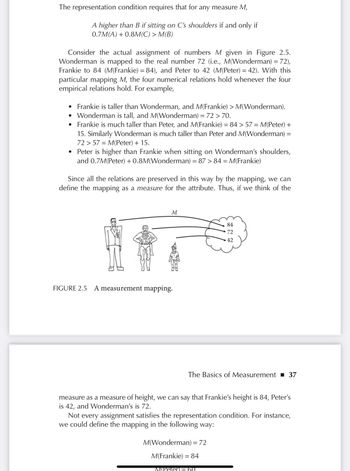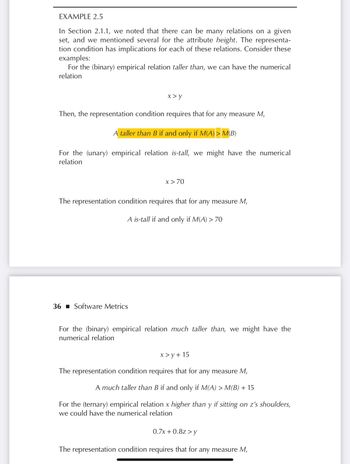
Database System Concepts
7th Edition
ISBN: 9780078022159
Author: Abraham Silberschatz Professor, Henry F. Korth, S. Sudarshan
Publisher: McGraw-Hill Education
expand_more
expand_more
format_list_bulleted
Question
thumb_up100%
For the empirical and numerical relation system of Example 2.5, write a numerical assignment satisfy the representation condition
example 2.5 in text2_Fenton, Norman - Software Metrics_ A Rigorous and Practical Approach, Third Edition (2014, CRC Press).pdf

Transcribed Image Text:The representation condition requires that for any measure M,
A higher than B if sitting on C's shoulders if and only if
0.7M(A) +0.8M(C) > M(B)
Consider the actual assignment of numbers M given in Figure 2.5.
Wonderman is mapped to the real number 72 (i.e., M(Wonderman) = 72),
Frankie to 84 (M(Frankie) = 84), and Peter to 42 (M(Peter) = 42). With this
particular mapping M, the four numerical relations hold whenever the four
empirical relations hold. For example,
• Frankie is taller than Wonderman, and M(Frankie) > M(Wonderman).
• Wonderman is tall, and M(Wonderman) = 72 > 70.
●
Frankie is much taller than Peter, and M(Frankie) = 84 > 57 = M(Peter) +
15. Similarly Wonderman is much taller than Peter and M(Wonderman)
72 > 57 = M(Peter) + 15.
Peter is higher than Frankie when sitting on Wonderman's shoulders,
and 0.7M(Peter) + 0.8M(Wonderman) = 87 > 84 = M(Frankie)
Since all the relations are preserved in this way by the mapping, we can
define the mapping as a measure for the attribute. Thus, if we think of the
M
FIGURE 2.5 A measurement mapping.
=
84
72
42
The Basics of Measurement ■ 37
measure as a measure of height, we can say that Frankie's height is 84, Peter's
is 42, and Wonderman's is 72.
M(Wonderman) = 72
M(Frankie) = 84
Not every assignment satisfies the representation condition. For instance,
we could define the mapping in the following way:
M(Peter) = 60

Transcribed Image Text:EXAMPLE 2.5
In Section 2.1.1, we noted that there can be many relations on a given
set, and we mentioned several for the attribute height. The representa-
tion condition has implications for each of these relations. Consider these
examples:
For the (binary) empirical relation taller than, we can have the numerical
relation
x> y
Then, the representation condition requires that for any measure M,
A taller than B if and only if M(A) > M(B)
For the (unary) empirical relation is-tall, we might have the numerical
relation
36 Software Metrics
x > 70
The representation condition requires that for any measure M,
A is-tall if and only if M(A) > 70
For the (binary) empirical relation much taller than, we might have the
numerical relation
x>y+15
The representation condition requires that for any measure M,
A much taller than B if and only if M(A) > M(B) + 15
For the (ternary) empirical relation x higher than y if sitting on z's shoulders,
we could have the numerical relation
0.7x + 0.8z>y
The representation condition requires that for any measure M,
Expert Solution
This question has been solved!
Explore an expertly crafted, step-by-step solution for a thorough understanding of key concepts.
Step by stepSolved in 3 steps with 15 images

Knowledge Booster
Learn more about
Need a deep-dive on the concept behind this application? Look no further. Learn more about this topic, computer-science and related others by exploring similar questions and additional content below.Similar questions
- The class I'm taking is computer science discrete structures. I am completely stuck. Please help! If you can please add an explanation with answer so I can better understand . Thank you!arrow_forwardWhen the issue set contains only nominal characteristics, vector space-based classification algorithms are usually not the best solution. What are your thoughts on this statement? How would you utilise machine learning to categorise nominal data?arrow_forwardThe USES relation naturally forms a graph. As mentioned in the lecture, the USES relation graph should be a Directed Acyclic Graph (DAG). (1) A graph could be represented with two different data structures, i.e., adjacency list and adjacency matrix. Represent the USES relation graph in Figure 3-1 with adjacency list and adjacency matrix. 3 2 4 5 6. Figure 3-1: USES relation graph of the modules in a system (2) Suppose the input of a USES relation graph is represented with adjacency list, develop a function in pseudocode to check whether the USES relation graph is an acyclic graph, using Stepwise Refinement technique taught in lectures. You should provide with at least 2 refinements. Assuming there are V vertices and E edges, please state the time complexity of your algorithm.arrow_forward
- Make sure to show the correct work and solution:arrow_forwardIf you had to describe a perceptron network model, what would you say it is? How may this approach be used for straightforward linear classification, whereby objects are divided into two categories according to a linear border and two feature dimensions? To demonstrate how elementary logical operations (like AND and OR) function? In a perceptron model, what logical procedure does not function? In a perceptron model, what logical operation does not work? Can all the fundamental logical operations be modeled by a single modification to the feedforward network model?arrow_forwardalgorithmsarrow_forward
- Determine whether the given relation is reflexive, symmetric, anti-symmetric and transitive (x, y)∈R if and only if y=x is less than and equal to x^2arrow_forwardLet R be an equivalence relation on A = {0,5,7,9} and R = {(0, 9), (0, 5), (7, 7), (9, 5), (5,9), (9, 9), (5, 0), (0, 0), (9, 0), (5,5)}. Answer each of the following questions. (5) = 0 [9] = [0] = [7] =arrow_forwardWhen the issue set consists entirely of nominal characteristics, vector space-based classification algorithms are often not the best option. Your thoughts on this assertion? How would you use ML to the task of categorizing nominal data?arrow_forward
arrow_back_ios
arrow_forward_ios
Recommended textbooks for you
 Database System ConceptsComputer ScienceISBN:9780078022159Author:Abraham Silberschatz Professor, Henry F. Korth, S. SudarshanPublisher:McGraw-Hill Education
Database System ConceptsComputer ScienceISBN:9780078022159Author:Abraham Silberschatz Professor, Henry F. Korth, S. SudarshanPublisher:McGraw-Hill Education Starting Out with Python (4th Edition)Computer ScienceISBN:9780134444321Author:Tony GaddisPublisher:PEARSON
Starting Out with Python (4th Edition)Computer ScienceISBN:9780134444321Author:Tony GaddisPublisher:PEARSON Digital Fundamentals (11th Edition)Computer ScienceISBN:9780132737968Author:Thomas L. FloydPublisher:PEARSON
Digital Fundamentals (11th Edition)Computer ScienceISBN:9780132737968Author:Thomas L. FloydPublisher:PEARSON C How to Program (8th Edition)Computer ScienceISBN:9780133976892Author:Paul J. Deitel, Harvey DeitelPublisher:PEARSON
C How to Program (8th Edition)Computer ScienceISBN:9780133976892Author:Paul J. Deitel, Harvey DeitelPublisher:PEARSON Database Systems: Design, Implementation, & Manag...Computer ScienceISBN:9781337627900Author:Carlos Coronel, Steven MorrisPublisher:Cengage Learning
Database Systems: Design, Implementation, & Manag...Computer ScienceISBN:9781337627900Author:Carlos Coronel, Steven MorrisPublisher:Cengage Learning Programmable Logic ControllersComputer ScienceISBN:9780073373843Author:Frank D. PetruzellaPublisher:McGraw-Hill Education
Programmable Logic ControllersComputer ScienceISBN:9780073373843Author:Frank D. PetruzellaPublisher:McGraw-Hill Education

Database System Concepts
Computer Science
ISBN:9780078022159
Author:Abraham Silberschatz Professor, Henry F. Korth, S. Sudarshan
Publisher:McGraw-Hill Education

Starting Out with Python (4th Edition)
Computer Science
ISBN:9780134444321
Author:Tony Gaddis
Publisher:PEARSON

Digital Fundamentals (11th Edition)
Computer Science
ISBN:9780132737968
Author:Thomas L. Floyd
Publisher:PEARSON

C How to Program (8th Edition)
Computer Science
ISBN:9780133976892
Author:Paul J. Deitel, Harvey Deitel
Publisher:PEARSON

Database Systems: Design, Implementation, & Manag...
Computer Science
ISBN:9781337627900
Author:Carlos Coronel, Steven Morris
Publisher:Cengage Learning

Programmable Logic Controllers
Computer Science
ISBN:9780073373843
Author:Frank D. Petruzella
Publisher:McGraw-Hill Education